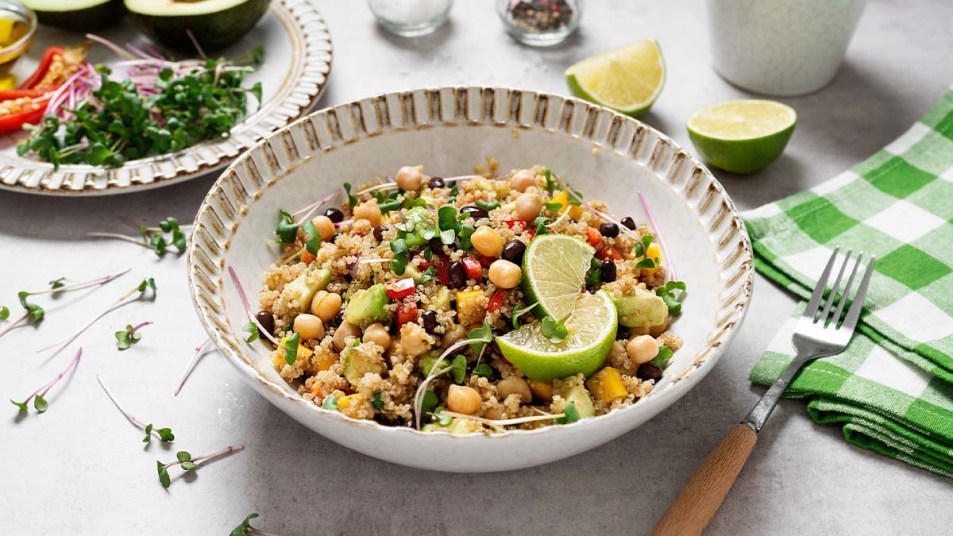Eating Like This Is a Natural Way to Reduce Painful Arthritis Symptoms, Study Finds

Making a diet switch might sound extreme, but for a health condition like rheumatoid arthritis, it’s worth looking into. Eating sugary foods, processed meats, and not enough fruits and veggies eventually leads to inflammation, which can cause joint pain and swelling. Studies suggest that adopting a vegan diet is the way to go. But how long would you have to maintain the vegan diet before you saw results? You might not be willing to do it. However, new research reveals that eating a vegan diet has anti-inflammatory perks to decrease painful arthritis symptoms.
Exciting Research
A recent study published in American Journal of Lifestyle Medicine looked at the impact diet has on arthritis pain and severity. Study participants included 44 adults previously diagnosed with rheumatoid arthritis (a chronic disease found mostly in the small joints of the hands or feet that causes pain, stiffness, and loss of or reduced range of motion).
Researchers from the Physicians Committee for Responsible Medicine (PCRM) randomly assigned the study’s participants to one of two groups: The diet phase group and the supplement phase group. In the first four weeks of the study, the diet phase group ate an exclusively vegan diet.
After the first four weeks, the diet phase group continued to eat a vegan diet for another three weeks — eliminating additional foods containing ingredients like sugar, soy products, and alcohol. For the remaining nine weeks of the initial 16-week diet phase, the foods that were eliminated in the fifth, sixth, and seventh weeks were gradually and individually reintroduced to the participants.
On the other hand, the supplement phase group ate an unrestricted diet for the entire 16 weeks of the first phase. In addition, they took a daily supplement (placebo) issued by the researchers, which contained small amounts of alpha-linolenic acid and vitamin E. The authors believed that this placebo could help to lower inflammation.
In the second phase of the study, which was another 16 weeks, the two groups switched diets; the diet phase group resumed a non-vegan diet and received a daily placebo, and the supplement phase ate a strictly vegan diet.
The Findings
Researchers found that, on average, the Disease Activity Score-28 (DAS28) for the study’s 44 participants decreased by two points during the vegan diet phase, which lead to substantially lower levels of joint pain. In the placebo phase, the DAS28 decreased by less than half a point.
Additionally, the average number of swollen joints declined by nearly four points, going from seven to 3.3 in the vegan phase. That number increased from 4.7 to five in the placebo phase.
It’s clear that the vegan diet did wonders for relieving painful arthritis symptoms, but the benefits don’t stop there. Researchers also discovered that participants lost an average of 14 pounds on the vegan diet. This is significant when compared to the two pound weight gain they experienced during the placebo phase. Plus, participants’ cholesterol levels dropped while on the vegan diet.
Neal Barnard, MD, who is the president of the PCRM and the study’s lead author, says that a diet-first approach can be helpful for those with arthritis. “The [vegan] diet is safe, healthful, and easy to do,” he says. “Arthritis medications cost tens of thousands of dollars and have side effects, so if some people can ease their symptoms without them, it’s great.”
How do you start eating vegan?
A vegan diet consists of eating only fruits, veggies, grains, and nuts (rather than animal-based products such as dairy, eggs, meat, or fish). This might be a big shift in your daily eating habits, but Dr. Barnard notes that you shouldn’t knock it until you’ve tried it: “Most people who adopt a healthy [vegan] diet discover that they feel so good — they lose weight and lower their cholesterol, in addition to easing their pain — they want to stick with it.”
To get you started on the right foot, he shares two rules of thumb for getting plenty of nutrients from a plant-based diet:
- Build your meals based on vegetables, fruits, whole grains, and beans. “That might mean bean chili instead of meat chili, a veggie burger instead of a meat burger, or topping your spaghetti with tomato sauce instead of meat sauce,” he says.
- Be sure to have a supplement of vitamin B12. “That’s important for everyone, for healthy nerves and healthy blood,” he adds.
Dr. Barnard also highlights the PCRM’s free, non-commercial app called 21-Day Vegan Kickstart. It curates plant-based meal plans, recipes, and grocery lists to make your life a breeze. You can download the 21-Day Vegan Kickstart app on iOS and Android devices.
Thinking about adopting a vegan diet for its anti-inflammatory and arthritis pain-relieving benefits? Speak with your doctor before making any diet change. This helps you get the maximum benefit from eating a healthy diet.












